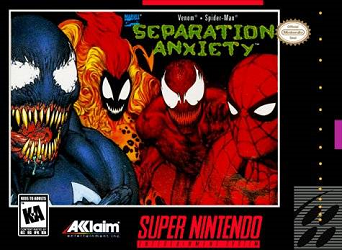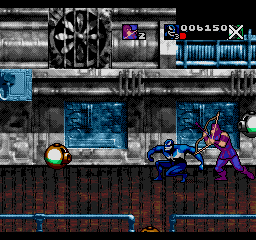- Spider-Man & Venom: Maximum Carnage
- Venom & Spider-Man: Separation Anxiety
While he started as a villain, Venom’s popularity lead to his transformation into an anti-hero with multiple mini-series to his name, including the titular Separation Anxiety, which explains why he gets first billing this time around.
The storyline, however, is not an adaptation of the mini-series but rather a mishmash of elements from various story arcs. Sometime after Maximum Carnage, Venom gets kidnapped by a secret organization known as the Life Foundation. They have built an underground city for their super-rich customers in the event of nuclear warfare and mean to reproduce Venom’s Symbiote in order to form a force to protect it. After managing to escape, Venom turns to Spider-Man for help, knowing he’ll need his support in order to take on the Life Foundation and destroy the five Symbiotes born from the experiments. They will also face constant attacks from The Jury, a private militia set up by a wealthy man with a grudge against Venom. This all explained in text-only cutscenes – no panels from the comics this time.

Genesis
Maximum Carnage was a big success, and the Genesis version of Separation Anxiety was released just 9 months later, with the SNES version following a few months down the line. As such, it is very similar to the first game in many ways. The basic gameplay is the same, though the web-based moves are slower than before so they aren’t as useful, and Power Hit are easier to build up. The first level is even a city area similar to the New York sections found in the first game, packed with the same thugs, creating some big-time deja vu.
There are, however, important differences. First, there is now two-player cooperative play, which completely changes the game’s dynamic. There’s a password system, too; you’re given one every three or four levels, and using it brings you back to the same point with 3 lives. They even had the decency to keep the passwords short enough. Its prequel could have really benefited from those additions, and it’s a shame they came a game too late.

Genesis
Because in other ways, Separation Anxiety is two steps backward. In an effort to differentiate the game from its prequel, Software Creations went for a different look, and the results are dubious at best. The sprites are oddly drawn and the goofy animations reminiscent of their earlier beat’-em-up The Tick. The rock soundtrack has been replaced with generic electronic music; once again, it sounds pretty different depending on the version, with the Genesis spoiling its tighter arrangements with the occasional ear-piercing sounds. The title screen theme is about the only piece that stands out thanks to its vocal samples and sense of urgency, particularly on the SNES. As you progress through the levels, you begin to encounter a few new enemy types and leave the city for a jungle, an underground city and some futuristic base sections. Many, many of those, actually. The pacing is a lot worse as levels are generally longer and you face wave after wave of the same few enemy types. It might all be too much if it weren’t for the password system allowing you to tackle it in two or three sessions.

Genesis
On the plus side, certain stages feature alternate routes and optional areas packed with goodies. Every now and then you will be taken to short levels called trap rooms in which you only fight an enemy group or two before moving on. The early boss battles are fairer too, as you now confront the Symbiotes (which are all pretty cool variations on Venom) and members of The Jury one-by-one before fighting them two-by-two later on in the game.

Genesis
The game seems to have been balanced for two players, featuring more aggressive opponents that are constantly maneuvering to get behind you and giving you only three lives and no credits to start with. The developers seem to have to realized this at some point and decided to compensate by packing the game with an extraordinary amount of extra lives, restorative items, and superhero icons, almost always in plain sight. This starts around the third level, so that the first level is actually one of the the hardest in the game. While it arguably breaks the game’s balance, spamming superhero summons five times in a row and just staying out of the way while Hawkeye does all the work is pretty fun in itself. Things adjust as you reach the final level, where you must face the game’s 10 bosses, two-by-two, before fighting Carnage himself. Beating each boss nets you either a full heart or an extra life, but there are no summon attacks to be found, making for a challenging battle. Thankfully, you’re given a password so that you can attempt it as many times as necessary.

Genesis
Separation Anxiety also received a little-known PC port. It was designed to run on Windows 95, making it overly complicated to play on modern computers. Not that there’s much of a reason to, as it looks and plays the same as the other versions and sounds worse than either.
While it has its good points, Separation Anxiety disappointed many Maximum Carnage fans and marked the end of the mini-series. By 1995 the beat-’em-up genre was on its way out and a new generation of hardware was making its entrance, so perhaps it was meant to end quickly. Software Creations continued making games under their own name until 2001, when they were absorbed into Acclaim for a short while before the publisher went bankrupt.
Comparison Screenshots

Genesis

SNES























